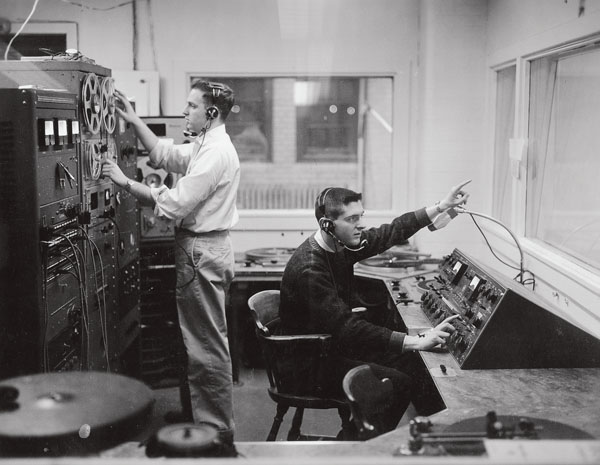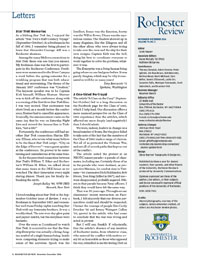Letters
As a lifelong Star Trek fan, I enjoyed the article “Star Trek’s Half-Century Voyage” (September-October). As a freshman in the fall of 1986, I remember being pleased to learn that Alexander Courage ’41E was a Rochester alumnus.
Among the many Meliora connections to Star Trek, there was one that you missed. My freshman class was the first to participate in the Rochester Conference. Freshmen were summoned to the River Campus a week before the spring semester for a weeklong program that was both educational and entertaining. The theme of the January 1987 conference was “Creation.” The keynote speaker was to be Captain Kirk himself, William Shatner. Shatner was to kick off the conference along with a screening of the first three Star Trek films. I was very excited. That excitement was short lived, as a month before the conference, Shatner had to cancel his appearance. Ironically, the announcement came on the same day that he was on Saturday Night Live and uttered the famous line to Trekkies, “Get a life!”
Fortunately, the conference still had another Star Trek connection: Harlan Ellison. Ellison, who wrote what many believe to be the finest Star Trek script—“City on the Edge of Forever”—was a guest speaker at the conference. He proved to be entertaining and cantankerous at the same time.
As for the perceived connection between Star Trek’s William T. Riker and Rochester’s William H. Riker, we talked about that many times at the DKE house as we watched The Next Generation every night during dinner. Thank you for finally debunking the myth.
Joseph Bailey ’90, ’97W (MS)
Newark, New York
I loved reading about Star Trek in the September-October issue of Review. I was a freshman in September 1967, and remember well those Friday nights watching Star Trek with my fraternity brothers. It was a weekly ritual. The sets were day-glow paint and papier-mâché, but the storylines were fantastic.
Over the years as I continued to watch Star Trek, it occurred to me that the Starship Enterprise was actually a living Jungian symbol of a single human being. Inside were competing elements trying to make sense of the universe. Spock was the Intellect, Bones was the Emotion, Scotty was the Will to Power, Uhura was the mysterious Anima. The Shadow showed up in many disguises, like the Klingons and all the other aliens who were always trying to take over the crew and the ship for their own designs. Captain Kirk was the Self, doing his best to coordinate everyone to work together to solve the problem, whatever it was.
The Enterprise was a living human being going where no one had gone before. It was purely Jungian, which may be why it resonated so well for so many years!
Tony Boccaccio ’71
Spokane, Washington
A One-Sided Portrayal
The article “A Class on the Cusp” (September-October) led to a long discussion on the Facebook page for the Class of 1966, which I help lead. Our discussion offers a more nuanced perspective on the Class of 1966 experience than the article’s, which affected me more deeply (and negatively) than I should admit.
We were, indeed, leaders in change on a broad number of fronts. But the piece failed to take note of the fact that the members of the Class of 1966 made a range of choices. Not all of us protested the Vietnam War, and not all of us took paths that kept us out of the conflict.
The article noted the protest at an NROTC sunset parade—a parade of classmates, including me. Certainly those of us in the parade who were destined, as prospective Marines, for combat duty in Vietnam—’66 classmates Dick Hulslander, Bob Rivers, Tom King (killed in 1967), and me—were disappointed, probably angered. Others in that parade became Navy officers. I think they would have felt the same way.
That was 50 years ago. Throughout our classmates’ recent interaction on Facebook, I felt sincerely that our diverse perspectives could and should be respected. I honor the courage of people like Cecily Drucker ’66 and Betsey Weingart Cullen ’66, quoted in the article, who had come to conclude that the war was wrong and acted in protest.
But I will say, frankly if reluctantly, that the article’s absence of any mention of Rochester mates, from whatever class, who entered the conflict with motives every bit as honorable as those who opposed the war, rekindled in me the feeling I felt on returning to the United States in 1968. No one cared, and no one had a word of kindness, empathy, or interest.
That is not how those participating in our Facebook group have approached our discussion. I feel strongly that the gap that might have existed between us is closed.
I wish the author and editors of the Rochester Review article had taken notice of this other part of the Class of 1966 experience and offered it the respect it gave to the protest wing. Our class was a much more complex group than the article gave us credit for being.
Andres Vaart ’66
Reston, Virginia
A Nod to Goethe
I have vivid memories of the antiwar vigil written about in “A Class on the Cusp” (September-October). We in the Student Peace Union had negotiated with the ROTC, who agreed that we could hold our vigil and that they would march around us. We certainly were pleased, and a bit surprised, by their cooperation. We sat quietly holding a banner calling for “Peace in Vietnam.” All of a sudden, some students from the crowd rushed over and torched the banner. It took every ounce of our new training in nonviolent resistance to prevent each of us from reacting with force against our attackers. It was a remarkable moment, as I remember: the sun was strong behind us, the banner was burning, and ROTC was marching.
On another, completely different, issue, I’d like to add a tidbit to the fascinating description of Susan Gustafson’s new book on Goethe (“Love Is All You Need,” September-October): that he married the mother of his children after 18 years of living together. In the 1960s, we liked to think we were challenging societal expectations. But Goethe, for one, was way ahead of us.
Louise Forsyth ’68
Brooklyn, New York
An Ode to English
Russell Peck’s recollections of Russ MacDonald brought back some happy memories for me of life in the English department as an undergraduate back in the late 1970s.
I was among Russ’s first students when he arrived to teach Shakespeare, and I appreciated his energy and insights. Russell Peck’s classes were the most thrilling and intellectually challenging of my time at Rochester. I still look back at passages he read to the class for their sheer beauty: for example, Book 22 of the Iliad, in which the Trojan women wash their clothes before the war; and the story of Francesca and Paolo in Canto V of Dante’s Inferno. I’m still stirred by the words.
I also studied with Cyrus Hoy, George Ford, Joseph Summers, and Jim Rieger—distinguished scholars who loved the classroom. I went on to earn a master’s degree in English from the University of Virginia, and from there to law school, but I will never forget the education I received in the English department at Rochester.
Robert Cohen ’80
Media, Pennsylvania
 STATIONED: Program manager Waltuck (left) and engineer Lambert in the early days of WRUR. (Photo: University Libraries/Department of Rare Books, Special Collections, and Preservation)
STATIONED: Program manager Waltuck (left) and engineer Lambert in the early days of WRUR. (Photo: University Libraries/Department of Rare Books, Special Collections, and Preservation)Radio Days
Several people wrote in to identify the two WRUR crew members pictured in the opening photograph of Class Notes (“Turn On, Tune In, Drop In,” September-October). Among them were the crew members themselves: Joseph Lambert ’59 (right, seated) and Morey Waltuck ’59.
“We were roommates our junior year and we both worked at WRUR. I was a program manager on Monday nights,” Waltuck writes.
“Notice there are three turntables. That was how the music was played. While the host was introducing the music, we would place the needle on the recording and listen for the break between the songs. Then, holding the pad under the record so it would not spin, we turned on the turntable and let go of the pad as soon as the host gave us the signal. This was because the turntables took too long to get up to speed.
“I remember waiting for printouts of the news from a teletype machine just before the top of the hour, then hurrying it into the small room that was just behind where the photographer was standing to take this picture. Then we would sit down to read the news into a microphone. Once, the news came in so late that I had to tear off the printout before it was finished and run to the microphone. While I was reading it, someone else tore off the rest of the news when it finished and brought it to me in time for me to continue reading it. The teletype machine typed onto a continuous roll of paper, one letter at a time, as it came in from the Associated Press—excruciatingly slow by today’s standards.”
Joseph Lambert adds: “I was an engineer at WRUR for much of my time at the U of R. Although my responsibilities were mainly in the studio, I traveled with the basketball team regularly to engineer remote broadcasts from other college campuses.
“This photo was published in the 1959 Interpres. As layout editor of our yearbook, I think I had something to do with not only getting this photo into the book, but having it very prominently placed!
“Morey and I met as college freshmen in 1955, roomed together as juniors, and have remained close friends to this date—an interval of 61 years! I often tease him that he is indeed my ‘oldest friend.’ ”
We also heard from David Appelbaum ’59. “We were classmates and fraternity brothers in Sigma Alpha Mu,” he writes. “I had a Sunday night show, ‘The Music Hour,’ and briefly served as a studio engineer during my freshman year.”
Review welcomes letters and will print them as space permits. Letters may be edited for brevity and clarity. Unsigned letters cannot be used. Send letters to Rochester Review, 22 Wallis Hall, P.O. Box 270044, University of Rochester, Rochester, NY 14627-0044; rochrev@rochester.edu.

